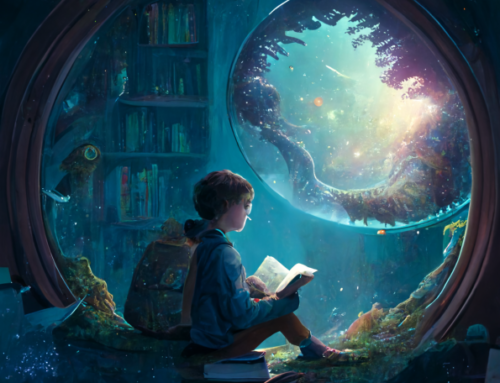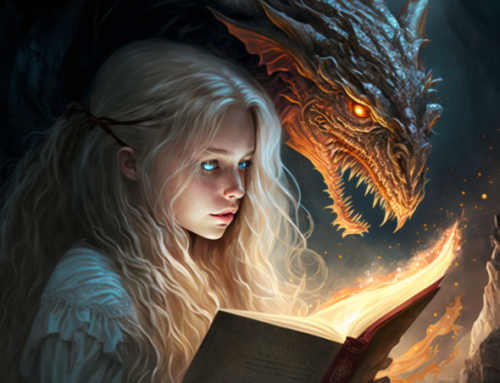In recent years, there has been a growing interest in eco-fantasy and eco-fiction among readers of all ages. These genres combine the elements of fantasy and science fiction with a focus on environmental issues, sustainability, and the impact of human actions on the planet. In this blog post, we will explore what eco-fantasy and eco-fiction are and why you should encourage your children to read them.
What is Eco-Fantasy?
Eco-fantasy is a sub-genre of fantasy that deals with environmental themes, ecological systems, and the impact of human activities on the natural world. It features characters who are in tune with nature and who have a deep understanding of the interconnectedness of all things. Eco-fantasy stories often explore the balance between the natural world and human society, and how the two can coexist in harmony.
Examples of popular eco-fantasy books include The Lord of the Rings by J.R.R. Tolkien, The Earthsea Cycle by Ursula K. Le Guin, and The Mists of Avalon by Marion Zimmer Bradley.
What is Eco-Fiction?
Eco-fiction, also known as climate fiction or cli-fi, is a genre of fiction that focuses on the impact of climate change on the planet and humanity. It often takes a realistic and speculative approach to explore the consequences of environmental degradation and human actions on the planet.
Eco-fiction stories typically feature characters who are affected by climate change and who must adapt to survive. They also address the ethical and moral dilemmas surrounding environmental issues and the need for sustainable solutions.
Examples of popular eco-fiction books include The Water Will Come by Jeff Goodell, The Overstory by Richard Powers, and The Children of Men by P.D. James.
Why Should You Encourage Your Children to Read Eco-Fantasy and Eco-Fiction?
There are several reasons why you should encourage your children to read eco-fantasy and eco-fiction. Here are a few of them:
Environmental Awareness
Eco-fantasy and eco-fiction books can raise awareness about environmental issues and encourage children to think critically about the impact of human actions on the planet. These books can help children to develop a sense of empathy towards the natural world and to understand the importance of protecting it.
Imagination and Creativity
Eco-fantasy and eco-fiction books often feature imaginative and fantastical settings that can spark children’s creativity and imagination. These books can transport children to new worlds and introduce them to unique and diverse characters.
Empowerment
Eco-fantasy and eco-fiction books often feature characters who take action to protect the environment and who work to create a more sustainable future. Reading these books can inspire children to take action in their own lives and to become agents of change in their communities.
Education
Eco-fantasy and eco-fiction books can teach children about science, ecology, and the environment in an engaging and entertaining way. These books can help children to understand complex scientific concepts and to appreciate the diversity of life on Earth.
Eco-fantasy and eco-fiction are important genres that can inspire and educate children about the environment and the need for sustainable solutions. By encouraging your children to read these books, you can help to raise their awareness about environmental issues, spark their imagination, empower them to take action and provide them with a valuable education. So go ahead and pick up an eco-fantasy or eco-fiction book for your child today!
Here are a few good ones you can start with including my most recent eco-fantasy novel for young adult readers:
Rainforest Shaman by W. Bradford Swift – Embark on an enthralling journey through the lush Amazonian jungle in Rainforest Shaman, where ancient wisdom and enchanting spirits clash with corporate greed, in a race to protect nature’s heart from ruin.
Hoot by Carl Hiaasen – This book follows a group of kids who team up to save endangered owls and their habitat from a developer’s bulldozers. The
The Lorax by Dr. Seuss – This classic children’s book tells the story of a creature called the Lorax who speaks for the trees and tries to protect them from destruction by the Once-ler.
The One and Only Ivan by Katherine Applegate – This book is based on a true story and follows the life of Ivan, a captive gorilla who dreams of living in the wild and finding a home for himself and his friends.
The Wild Robot by Peter Brown – This book tells the story of a robot who washes up on an island and must learn to live in harmony with the island’s wildlife and ecosystem.
Pax by Sara Pennypacker – This book is about a boy and his pet fox who are separated by war and their journey to find each other.
Island of the Blue Dolphins by Scott O’Dell – This book is based on the true story of a Native American girl who is left alone on an island and must survive on her own, while also learning to live in harmony with the island’s wildlife.
The Last Unicorn by Peter S. Beagle – This book is about a unicorn who goes on a quest to find out why she is the last of her kind and the impact humans have on the natural world.
The Secret of the Old Mill by Franklin W. Dixon – This book is part of the classic Hardy Boys series and follows the brothers as they investigate the pollution of a local river and the impact it is having on the local wildlife.
The Green Ember by S.D. Smith – This book is about a family of rabbits who must band together to fight against an evil force that is destroying their forest home.
Tuck Everlasting by Natalie Babbitt – This book is about a family who has discovered the secret to eternal life and the impact it has on the natural cycle of life and death.
These books are excellent examples of eco-fantasy and eco-fiction that can capture the imagination of young readers while also teaching them valuable lessons about the environment and sustainability. They’re both entertaining and educational, making them great choices for children to read.





Leave A Comment